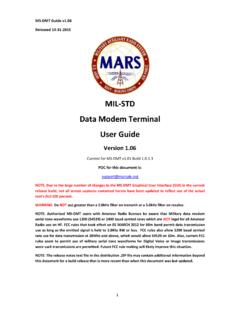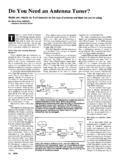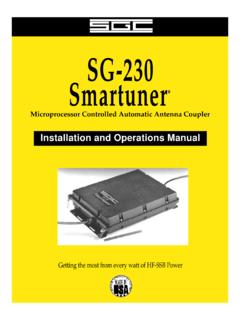Transcription of AAR2EY All Band NVIS Antennae Designs - N2CKH
1 AAR2EY All band nvis Antennae Designs Updated 20 May 2007 Updated 23 February 2006 Updated 9 November 2005 Started 13 February 2004 As user of MF/HF frequencies, a dedicated a Near Vertical Incident Skywave ( nvis ) is a requirement and not an option in my opinion. In addition a broadband nvis antenna is a necessity for MARS/SHARES operations and especially for Automatic Link Establishment (ALE) operations. As such I offer three proven Antennae Designs herein for consideration as effective, inexpensive and easy to install and maintain nvis antenna types. This piece was originally written a few years back to assist my fellow NJ Army MARS members in achieving better performing nvis Antennae installations to improve our statewide operations as many members were using anything but a proper nvis antenna at that time.
2 In the years since then I have been working with many Tri-Service MARS stations setting up antenna for use with ALE operations up and down the East Coast and in land which I personally communicate and the performance results of members changing over to nvis antenna have been clearly seen. As to an ALE focus in particular, everyone needs to not only be using an optimal nvis Antennae , but also a broadband nvis antenna due to the automatic frequency hoping nature of ALE. At present the MARS channels for our current 24/7 ALE network span from nvis through Skywave where a 10 channel MARS Tri-Service ALE network exists from 2 Mhz to nearly 28 Mhz, thus random wire antenna performance with gain above 12 Mhz is of interest.
3 nvis Antennae types come in many sizes and shapes with various characteristics, some are broadband and some are not, some less expensive to build and some very expensive to purchase, some are designed for all weather and some are not. Most Designs are usually less expensive and usually better made when home made. This document details three relatively inexpensive (parts for any one of them should not cost more than around $150 USD) nvis antenna Designs that are both very effective broad band Designs which offer maximum RF energy transfer to the radiating part of the antenna and minimum losses. All of the antenna Designs and associated data presented herein is achieved without the use of any counterpoise (which I consider to be a hazard to foot traffic), however the use of good earth grounds at the station and baluns are required.
4 I make no claims to be an expert on Antennae design , as many have before me, I have read my fair share of reference material on the subject, however I have never found broad band nvis Designs detailed that were totally suitable to my needs. I and others have found two of these antenna Designs (the one with 300 ohm twin lead is being published for the first time) herein to work very well at many locations around the for a number of years now. Although these Designs may not be perfect (if there is such a thing as a perfect broadband, efficient HF nvis antenna) they perform quite well, are efficient radiators and are not at all difficult to assemble, install or maintain and are relatively rugged and inexpensive and will withstand high power operations as may be desired.
5 I have used all three Designs in 24/7 ALE operations as well as other modes and tested them at high power levels (making sure that no one was anywhere around the property when testing the low to the ground models) when not involved in nvis operations. This document is not a technical paper on the subject of nvis , however, herein I will cover some basic facts regarding nvis operation for the new comer to the subject matter. I shall also provide some pointers on testing and maintaining your antenna. In addition, I shall list sources for the major parts used in construction that may be hard to find in some areas. I am not associated with any product or firm that is mentioned within this document. THE ANTENNA Designs 1. AAR2EY HALF WAVE DOUBLET nvis ANTENNA The first nvis antenna design introduced herein has been used for years now and is basically low to the ground mounted wave all band doublet configured about half way between being an inverted V and dipole to favor nvis performance.
6 It is cut for a lowest resonant frequency of ( :1 VSWR at my location) and requires the use of an antenna tuner for most all other frequencies. I fed this antenna with my preference of 450 ohm low loss ladder line for the bulk of the transmission line run after the broadband RF transformer (featuring high RF power rating) provides a high efficiency design which can be used to operate on frequencies from 2-28 MHz (and beyond). The 450 ohm ladder line provides ease of handling for installation and maintenance as compared to the use of a 600 ohm open feed. The 450 ohm ladder line also has advantages over 600 ohm open feeder with respect to potential damage due to bad weather and shorting due to icing. The use of ladder line (or if desired, 600 ohm open wire feed) provides low loss and excellent high power handling characteristics when required.
7 I use 12 gauge ladder line as the conductors being larger, the loss is less and with the impedance being higher (12 gauge is closer to 450 ohms than is 14 gauge) smaller I2R losses for the matched condition exist. The use of an external 9:1 vs. 4:1 ratio balun provides for a better match of the 450 ohm ladder line to the 50 ohm cable. My antenna is resonant at with a :1 VSWR, there are actually multiple points at which the direct match of less than :1 is achieved, however this antenna design requires the use of antenna for most frequencies. However, the nvis performance, broad band performance, low loss characteristics and radiation efficiency of the antenna are more important than that of the VSWR. Though, in my opinion, the other key factor of this antenna is that all my various make and models of radios which have automatic antenna tuners, will operate very rapidly with this configuration, as the VSWR direct is never much more than :1 anywhere that I need to use it and the reactance of the antenna is well within the capability of most but not all automatic antenna tuners.
8 All feed lines will exhibit higher losses when feeding a load that does not match their characteristic impedance. These losses are due to reflections traversing the line. Coax cable is lossy, even at HF, for example, the loss of 100 feet of open wire line at an VSWR of 20:1 at 30 MHz will be dB total. Good quality RG-8 looking into that same 20:1 VSWR will show a loss of over 5 dB. Even if the RG-8 is perfectly matched for minimum loss, 100 feet of it will show a greater loss than the open wire line at about dB at 30 MHz. When you have high voltage standing wave ratios at various frequencies to contend with, coax cable can also flash over and short. This nvis antenna design by employing the 9:1 balun provides for the use of most internal and external automatic antenna tuners for rapid frequency change (QSY) under control operator direction or automated frequency changes using Automatic Link Establishment (ALE) use when ALE multi-channel scanning operation is employed.
9 However some older ATU types which only support a :1 VSWR 5-150 ohm tuning range many not be able to tune this antenna at all frequencies. More modern automatic ATU s such as the LDG Electronics line which features models that support a 10:1 VSWR from 6-1000 ohms are more suitable for use with this type of antenna. As an alternative to the automatic antenna tuner, you can obviously make use of a manual tuner of any variety (with bypass switch for auto tuner use) if you like. You do give up the rapid frequency change capability in doing so, however a manual tuner would be needed should you desire to make use of an external high power RF amplifier greater than 600 watts output. Before you say, my manual antenna tuner has a balun that I can use with ladder line, I want to make it clear that most all manual antenna tuners on the market today make use of a 4:1 balun (often, a poor balun at that) which would be pretty good for 300 ohm twin lead to 50 ohm coax, however they do not provide the proper ratio for 450 or 600 ohm lines.
10 Yes, conductor sizes and spacing affect the "characteristic impedance" of ladder line and open feeder. That is, the impedance of the circuit it must be used in if the VSWR is to be 1:1. When, we speak of "450-ohm ladder line" or "300 ohm twinlead" we are speaking of the "characteristic impedance" of the line. That has little real relationship to the impedance of the line in a real antenna system. Below is a table of frequency steps at 500khz from until the end of the nvis range at 12 Mhz at which point we change to 1 Mhz steps and corresponding VSWR readings for this antenna design as detailed and installed at my QTH. This table is provides some idea of the characteristic curve of this antenna which is resonant at.













